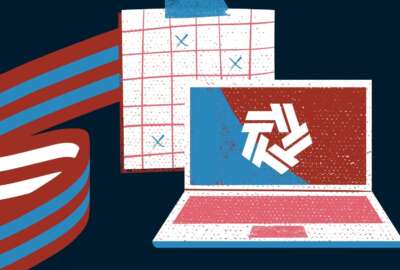

Hubbard Radio Washington DC, LLC. All rights reserved. This website is not intended for users located within the European Economic Area.
The Alliance for Digital Innovation, an industry association, is proposing seven changes to the GWAC model to bring it into the 21st Century.
For the Department of Health and Human Services, spending a higher percentage of its $40 billion procurement budget through governmentwide acquisition contracts isn’t just a matter of convenience.
It’s the way HHS will get a better and deeper view into where components are spending their fiscal 2021 procurement budget. The greater use of GWACs and other governmentwide multiple award contracts—known as “best-in-class” contracts—is how HHS will accelerate its use of data to drive spending decisions under the category management initiative.
Katrina Brisbon, associate deputy assistant secretary for acquisitions at HHS, said the agency hasn’t been an early adopter of category management.
“We are taking a fresh look at what our spend is. We have a very small cell of individuals who are doing this so a lot of this is driven by resources. I’m happy to say most recently, we have gotten authorization to get an additional team and we will be bringing a team on, we hope, in the early part of the fiscal year to broaden out our category management oversight and engagement more broadly,” Brisbon said during the Procurement Trends conference sponsored by the Professional Services Council. “We are at about 20% of where our goals are for the fiscal year [for spend under management]. We are looking to meet those goals, but we have a ways to go. But more importantly, we are working toward it by targeting more and more GWACs on our spend so that we can indeed ensure that HHS is joining the rest of government to ensure we are getting better buying power across our spend.”
HHS isn’t alone in its increased use of GWACs and other multiple award contracts. Bloomberg Government reported agencies spent more money through multiple award contracts in fiscal 2020 than ever before. Agencies obligated $159 billion through more than 2,000 of these acquisition vehicles.
BGov said about one-half of all MAC spending was for IT and professional services last year.
To that point, NASA’s Solution for Enterprisewide Procurement (SEWP) GWAC saw obligations increase by 40% last year alone.
Joanne Woyteck, the SEWP program manager, said at the PSC event 2021 is also turning out to be a record setting year with more than $10 billion in sales.
While the use of GWACs specifically continues to grow, the underlying model for these acquisition vehicles hasn’t changed since the mid-1990s when Congress created them in the Clinger-Cohen Act.
The Alliance for Digital Innovation, an industry association, is proposing changes to the GWAC model to bring it into the 21st Century.
“There’s really some issues here that we can highlight and help address and ways that we can talk about it in a positive reform-minded process where we can actually help early and often chart a course for how the Biden administration can leverage the power and the breadth of the GWACs, to drive a lot of the build back better agenda and to really help agencies get the products and services that they want,” said Matt Cornelius, the executive editor of the Alliance for Digital Innovation, in an interview with Federal News Network. “At the end of the day, the GWAC process and the acquisition process should be about ensuring that buyers have access to the best products and services available, and that their customers, the American citizens, get the highest satisfaction when they engage with the government.”
As the data demonstrates, it’s not that GWACs are struggling. Quite the contrary, Cornelius said, these vehicles are more important than ever so improving them by taking broader advantage of NASA or the General Services Administration or the National Institutes of Health’s IT Acquisition Assessment Center (NITAAC) individual innovations is an important part of their evolution.
“When you think about the GWACs and you think about the pressure and focus that the past couple of administrations as well as this one has had on the GWAC process, of trying to push toward more streamlining, more commoditization, more harmonization, were well intended, but the technology market, especially on the services side, is moving so much faster than where the GWACs can keep up,” he said. “The intent of the paper is to move away from the focus on that commoditization and streamlining and more on what are we doing to bring access to innovative products and services onto those contracts? How are we keeping the product catalog and the service catalog fresh so that as agency appetites and agency buying preferences evolve, these GWACs can be more customer oriented?”
ADI made seven recommendations to modernize GWACS, including moving toward a “show, don’t tell” evaluation approach to bidding, improve onboarding of new vendors and off-boarding of vendors who aren’t performing and making more use of commercial past performance examples.
Cornelius said better onboarding processes and the training of new entrants on how GWACs work would go a long way to giving agencies access to innovations.
“If you’re on a GWAC for 10 years, that has a tremendous barrier to innovation, especially for a lot of small and medium sized companies who plan to grow over that time and don’t want to be locked into just one particular contract. They don’t want to place their business bets today on what’s going to happen 10 years from now. They want access to be able to move around to these GWACS as their business grows and as they might acquire other companies or as they develop new product lines. I think the onboarding piece was what we heard even more vociferously from our members,” he said.
Emily Murphy, the former GSA administrator, said to bring innovation to GWACs, the use of the unpriced master contract approach is key.
“[T]o effectively promote innovation, GSA’s use of Section 876 authority on POLARIS should do more to promote customized and innovative responses,” Murphy said in an email to Federal News Network. “By focusing on technical capabilities for the initial award, POLARIS should deliver demonstrated technical competence that can be applied to problems not yet articulated by customer agencies, rather than simply demonstrating an existing commercial solution to a known challenge.”
Applying the Section 876 provision to GWACs more broadly fits in with ADI’s recommendation to evaluate more relevant criteria to get on the vehicle.
“[E]valuation criteria for GWACs should evolve to open the aperture for nontraditional commercial innovation. In those situations where past performance is based on work scope and project complexity, the government should explore ways to include relevant commercial use cases in the evaluation as part of the ‘past performance’ reviews,” the report states. “Such factors as ‘what was accomplished’ for the customer in terms of deliverables should play a prominent role. GWACs must move past ‘box checking’ exercises regarding work performed for existing federal agencies to address actual technical risk and focus upon implementing modern commercial capabilities that solve complex agency challenges.”
Cornelius said ADI plans to share the report with the Office of Management and Budget and with the relevant committees on Capitol Hill.
“I’m not saying there has to be a legislative solution to what we’re doing. There’s probably are some opportunities to tweak some of the acquisition laws and the budgeting laws to help move agencies more in the direction we’d like to see them go under the white paper,” he said. “This is going to be the start of many conversations, and there’s already a lot of activity. For us, this is the best way from the outside we can try to bring as many of those actors both on the policy and the management or implementation side together to focus on these recommendations, talk about how we can actually get them implemented, and then start to see some real progress happening.”
Copyright © 2024 Federal News Network. All rights reserved. This website is not intended for users located within the European Economic Area.
Jason Miller is executive editor of Federal News Network and directs news coverage on the people, policy and programs of the federal government.
Follow @jmillerWFED



